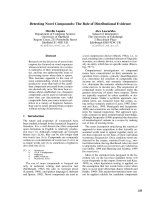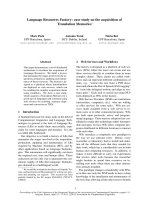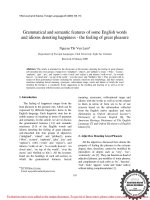The Sculpture of Greater India pot
Bạn đang xem bản rút gọn của tài liệu. Xem và tải ngay bản đầy đủ của tài liệu tại đây (11.85 MB, 18 trang )
The
Sculpture
of
Greater
India
by
A
S C
H
W
I
N
L I P
P
E
Associate Curator
of
Far Eastern Art
In
the new
gallery
of
Indian
sculpture,
which
will be
opened
on
February 24,
the
Museum's
collection,
enriched
by
many
generous
loans,
is
now
on
display
for the first time in
many
years.
It shows a
cross section of
what
Heinrich
Zimmer
has called
"one of
the most
magnificent
chapters
in
the
whole
history
both of the
world's art and
the
world's
religion."
When
we
speak
of Indian
sculpture
we do not
use
the name
in its ethnic or
political
sense
but
in
its
widest
possible
connotation,
as
in
the
ex-
pression
"Greater India."
We
cover an area
that
extends from modern
Afghanistan
to Vietnam
and
from
Nepal
to
Indonesia;
we
range
in time
from the third millennium B.C.
to late medieval
times. Most of these countries have never
been
under Indian
political
domination,
but
they
adopted
one or the
other
of the
great
Indian
religions
and
consequently
their art
was
stimu-
lated and
strongly
influenced
by
India.
This
may
justify
its inclusion
in
an Indian
gallery.
Neither
all
periods
nor
all areas
of this
Indian
cultural domain
are
represented
in
the new
gal-
lery.
Nor could the two historical
aspects
of
space
and time
always
be
properly
related
to each
other
or
to
the
exigencies
of
display.
We have
attempted,
however,
to show the
sequence
of
time
and
of
stylistic
periods
in
the
general
direc-
tion from
east
to west
along
the
length
of
the
gallery.
The two
principal
border
areas,
north
Pakistan-Afghanistan
and Cambodia-Thailand-
Indonesia,
have been allocated
the two far
ends
of
the
gallery
in order to
emphasize
their distinc-
tion from the main
body
of Indian
sculpture
proper.
All
Indian
sculpture
is
religious
sculpture.
We
enter
in this
gallery,
therefore,
a
spiritual
climate
that
may
best be
evoked
by
quoting
Stella Kram-
risch: "Indian
art conduces
to
fulfilling
the aims
of
life,
whose
ultimate aim
is
release." "Release
(moksha)
means,
for the
Indian,
inner
detach-
ment
combined
with the
realization
of
and
re-
integration
into the Absolute."
"Images
repre-
sent
the
gods
whose
proportions
are based
on
the
idealized
figure
of
man."
"Making
a
work
of
art
is
a
ritual.
By performing
the
rites of
art,
the
craftsman
transforms
himself as well as
his
ma-
terials.
He sees
the
image by
direct
intuition,
and
his conscious
vision
clothes it
in
the lineaments
that
not
only
take
the
shape
of
nature,
and
of
man
and
his
work,
but
also
evoke the
presence
of God."
All the stone
sculptures
we see
in
the
gallery
originally
were
parts
of
temples
or other
Contents
FEBRUARY
I960
Dancing
apsaras. Rajasthan,
India,
xII-xII
cen-
tury.
Height
28 inches
Gift
of
Mrs.
John
D.
Rockefeller,
Jr.,
1942
ON
THE
COVER:
Bronze
statue
of
Parvati.
Southeast
India,
Chola
dynasty,
about
goo.
Height
27
8
inches
Bequest
of Cora Timken
Burnett,
1957
The
Sculpture
of
Greater India
By
Aschwin
Lippe
A
Royal
French
Clock
By James
Parker
A Chardin
in
the Grand Manner
By
Colin
Eisler
I77
I93
203
177
The Metropolitan Museum of Art
is collaborating with JSTOR to digitize, preserve, and extend access to
The Metropolitan Museum of Art Bulletin
www.jstor.org
®
r'm
'
r
:C
]
i
-<a_
s@J'
,:~~~~~~~~~~~~~~~~~~~~~~~~~~~~~~~~~~~~~~~~~~~~~~~?
?L,~i
I~~~~~~~~~~~~~~~~~~~~~~~~~~~~~~~~~~~~~~~~~~~~~~~~~~~~~~~~~~~~~~~~~~~~~~~~~~~~~~~~~~~,~
1?1~~~~~~~~~~~~~~~
:::"?
-1
'I
-?
?ar
?*::a:
:::?:?
;:: ::::
6; ??
:?? :::
a? ?E
-::?
:a?.
ji,i
:::::::i-
?t?::
,,
I
t711Li-l ? IF'- arnut?:ic,:-
'Y- e :CR'
; ;t
I ri
- I I II ,._Cu ?.i:-j .:;,s;o n
rri
::i::
?:
&::::?
L'
religious
monuments
to
which
they
belonged
both
aesthetically
and
functionally.
We have
to
remember that
they
are shown
here
out
of the
context
essential
to the Indian
artist
and
the
Indian
beholder.
Though
only
a
few minor
sculptures
in
our
collection
antedate
the
beginning
of our
era,
they
cannot be
well understood without
refer-
ence
to the
vastly
older
religious
traditions
from
which
they
derive.
The cult of nature
spirits
like
yakshas
(tree-gods)
and their female
counter-
parts
the
yakshis,
or
nagas
and
naginis
(serpent
deities
of lakes
and
rivers)
is
probably
as
old as
human
civilization
in
India and
southeast
Asia.
The
Dravidian civilization
of
the
Indus
valley-
related
to ancient
Mesopotamia-flourished
be-
tween
3000
and
1500
B.C.
Its
principal gods
were
the
prototypes
of
Brahma
the
creator,
Vishnu
the
preserver,
Siva
the
destroyer,
and
especially
the
Goddess.
The
Aryan conquest
of the
Indus
valley
took
place
about
I500
B.C.,
and
in
the
process
of
the
Aryan
migration
across the
north
of
India
and
their
subsequent
infiltration
of
the
south,
the Dravidian
gods
of
the Indus
valley
cities were
superseded by
and
amalgamated
with
Aryan
gods
of
wind, water,
fire, sun,
et
cetera,
over
all
of whom
presided
the
king
of
the
gods,
Indra,
wielding
the thunderbolt
and command-
ing
the
rain clouds.
The next
millennium,
the
Vedic
period,
produced
a
synthesis
of the two
religions.
Gradually,
however,
the
native
Dra-
vidian
gods
in their
many
aspects
came
to
the
fore
again,
in
a slow but
irresistible G6tterdam-
merung
for the
Aryan
invaders.
Practically
all
Hindu
religious
art
as we
know it dates
from
periods
after
the
completion
of this
process.
It
includes
two
important
offshoots
from the
Hindu
tradition
which
became
powerful independent
The
Metropolitan
Museum
of
Art BU
LLETIN
VOLUME
XVIII,
NUMBER
6,
FEBRUARY
1960
Published
monthly
from October
to
June
and
quarterly
from
July
to
September. Copyright
I960
by
The
Metropolitan
Mu-
seum
of
Art,
Fifth
Avenue and
82nd
Street,
New York
28,
N.
Y.
Re-entered
as second-class
matter November
I7, I942,
at the
Post
Office
at New
York,
N.
Y.,
under the
Act of
August
24,
1912.
Subscriptions
$5.00
a
year.
Single
copies
fifty
cents.
Sent
free
to Museum
Members.
Four weeks' notice
required
for
change
of address.
Editor: Marshall
B.
Davidson;
Associate
Editor:
Rosine
Raoul;
Designer:
Peter
Oldenburg.
Marine
deities
or
boatmen.
Gandhara, Pakistan,
Kushan
period,
I-II
century. Height
6 inches
Rogers
Fund,
1913
religions:
Buddhism and
Jainism.
Both
are
part
of
the
Dravidian
resurgence,
and
they
have much
in
common
with each other.
Both
represent
the
materialistic-ascetic
trend
in Hindu
philosophy;
however,
as we shall see
in
our
sculptures,
this
did
not
prevent
their art
from
being
infiltrated
by
some of the
gods.
Buddhism
was
founded
by
the
Sakya
prince
Siddhartha
(about
563-483
B.
c.),
called
Gautama
(his
family
name)
or
Sakyamuni,
"the silent
sage
of
the
Sakyas."
Just
as
the Reformation
was
carried
by
the revolt
of the
princes against
the
secular
power
of the
Church,
Buddhism
repre-
sents the
revolt
of the
kshatriyas,
or warrior
caste,
against
the
brahmins,
the
all-powerful
priests.
During
the
reign
of Asoka
in
the
third
century
B.C.
Buddhism became
the
leading
religion
of
India;
Buddhist
art dominated
the
following
centuries
through
the
Gupta period
(fourth
to
sixth
century
A.D.).
In
the first
century
of
the
Christian
era
Buddhism
made
its
appearance
in
China;
a few
centuries later
it had
conquered,
more
or
less
permanently,
the whole
of
Asia.
Two
thousand
years
after
Asoka
it
still
flourished
from
Nepal
to
Japan
and
from
Ceylon
to
Thailand.
The
foundation
of
Jainism
is
generally
attri-
buted
by
Occidental
scholars
to
Mahavira,
a
contemporary
of the Buddha who
died
in
526
B.C.
The
Jaina
themselves,
however,
believe
Mahavira
to
have been the
twenty-fourth,
not
the
first,
tirthankara
(savior;
literally
"maker
of
the
river
crossing").
And the most
recent school
of Western
thought agrees
that
there
is some
truth
in
the
Jaina's
claim of the
antiquity
of their
religion,
which
certainly
existed
centuries
before
178
Musicians and dancers.
Gandhara,
Pakistan,
Ku-
shan
period,
I-mI
century. Height
6
4
inches
Rogers
Fund,
1913
the Buddha
and
may
date
back
to
pre-Aryan
times.
Jain
sculpture
(here
represented
only
by
some late medieval
examples)
provided
one
of
the
origins
of the
Buddha
image-the
other
be-
ing
the
Roman
provincial
art of Gandhara.
The first
clearly
defined
period
of
Indian art
after
the
Aryan conquest
of
the ancient
Dra-
vidian
civilization
is
that
of
the
Maurya
dynasty
(about
321-184
B.c.),
with its
capital
at
present-
day
Patna
on the
Ganges.
The
dynasty
was
founded
by
Chandragupta,
a
powerful camp
follower
of
Alexander
the
Great,
and reached its
peak
under his
grandson,
the famous Buddhist
emperor
Asoka,
whose domains
included most of
Afghanistan
and
Pakistan, Sind,
Kashmir,
Ne-
pal,
Bengal
to the
mouths
of
the
Ganges,
and
the northern
part
of
peninsular
India.
Maurya
sculpture,
though
not
represented
in
our
gallery,
is known
to visitors to
India
by
the
pillars
with
lion
or
bull
capitals
erected
by
Asoka;
these
highly
polished
heraldic animals show the
in-
fluence of Achaemenid
Persepolis.
The
Mauryas
were
followed
by
the
Sunga
dynasty
(about
I85-172
B.C.)
which
ruled
the
central and eastern
parts
of
northern India.
Some terracottas
in
our
gallery
are attributed
to
the
Sunga dynasty
and
can
probably
be
assigned
to the second
century
B.C. and
to
the
Mathura
region
between
Delhi
and
Agra. They
do
not
convey
even
an
approximate
notion
of
the
great
archaic
relief
sculpture
of
this
period
as
repre-
sented
on
the
stupas,
or relic
mounds,
of
Bharhut
and Sanchi. Not
very important
in
themselves,
they
are
still
the oldest
objects
in our
collection,
and
at
the same time
belong
to the main
stream
of
Indian artistic
tradition
that
begins
with
the
Indus civilization
and
leads us
through
the
Maurya
era-hardly
troubled
by
the
foreign
in-
flux of Gandhara-to
the
Kushana
sculpture
of
Mathura and
the
Andhra
stupas
of
Amaravati.
The
subject
of these
terracotta
figures
is,
per-
haps,
a
yakshi,
or
dryad;
at least
one
of
them
may
well
represent
the
mother
goddess
whom
we
know
under
various
aspects
from
ancient
Mesopotamia
and
the eastern
Mediterranean.
In
India
she was
worshiped
variously
as
the
mother
of
the
universe,
the
goddess
Earth,
the
goddess
Padma-Lakshmi,
or
simply
Devi,
the
Goddess.
During
the
millenniums
she has
shown
herself
under numerous
names
and
forms,
some
terrify-
ing,
some
benevolent,
and
we
shall
meet
her
repeatedly
in our
gallery.
The
great
interest
which,
since
Kipling,
West-
ern
scholars
and
collectors
have
felt
for
Gan-
dhara art
is
reflected
in
its
rich
representation
in this
Museum's
collection.
In
order
to understand
the existence
of
a
Western
school
of art
in northwest
India
we
have
to
make
an excursion
into
history
after
Alex-
ander
the
Great.
About
the
middle
of the third
179
century
B.C. the
Seleucid
empire
of
western
Asia
had
begun
to
disintegrate,
and Parthia
(north-
ern
Iran)
and
Bactria
(Afghanistan) gradually
emerged
as
independent
states. Demetrius
of
Bactria
invaded the
Ganges
valley
and
helped
to
bring
an end to
the
Maurya
empire;
the
Punjab
Bodhisattva,
perhaps
Siddhartha.
Gandhara,
Ku-
shan
period,
uI-III
century.
Height
30
inches
Gift
of Mrs.
John
D.
Rockefeller,
Jr.,
1942
OPPOSITE:
Maitreya.
Gandhara,
Afghanistan,
Kushan
period,
in
century.
Height
30
M
inches
Rogers Fund,
1920
and the
Northwest Frontier Province came
under
the
occupation
of
the Greeks.
In
the
middle
of
the second
century
B.C.
a
great
tribal
movement
began
in
central
Asia,
set
off
by
the
Chinese
campaigns
against
the
Hsiung-nu
(Huns).
The
Sakas
(Scythians)
and
the Yueh-chih
(Tochari,
a
Scythian
tribe
from
Kansu
in
northwest
China)
invaded
Parthia and
Bactria.
The Greek
rule
in
Bactria
was
replaced
by
the
Sakas
who,
in their
turn,
were forced
out
by
Parthian
pressure
and
established
themselves
in
Kashmir and
along
the
Indus.
The
city
of
Taxila
in
Gandhara,
east of the
upper
Indus,
was
taken at the close of
the first
century
B.C.,
which
ended
Greek
domination
here
as well.
By
the
middle of
the first
century
A.D.,
the
Kushanas,
a branch
of
the
Yiieh-chih,
established
their
rule
in
the
Kabul
valley,
until then still
governed
by
Greek
kings,
and in Kashmir.
Soon
they
con-
quered
Gandhara,
the
Punjab,
Sind,
and
the
Ganges
valley.
The
decapitated
statue
of
their
great King
Kanishka
I,
in
a
long
mantle and
felt
boots,
holding
sword and
mace,
can
still
be
ad-
mired in
Mathura,
one of
his
capitals.
The
Ku-
shana
kingdom
as well
as
the
surviving
Saka
realm
in
western India were
finally
overrun
by
the
Parthians
under
Shahpur
I,
about
250
A.
D.,
but
religious
and artistic activities
in
this area
came to
an
end
only
with the
devastating
invas-
ion
of
the
White
Huns,
about
500
A.D.,
who
destroyed
the monasteries
and butchered
the
population.
Being foreigners,
the
Kushana
rulers could
not
be
accepted
into the
Hindu
faith;
conse-
quently they
adopted
and
patronized
Buddhism.
All
the
arts
flourished
in
their domain. Famous
philosophers
and
poets
from
all over India
came
to
stay
at
their
court,
and
the
great
stupa
which
Kanishka
built
at
Peshawar was
admired as
a
wonder
of
the world
by
the Chinese
pilgrims
who visited the
holy
land
of
Buddhism.
Gandhara
enjoyed
its
period
of
greatest
pros-
perity
under Kanishka and
his successors.
But
Gandhara art
is
not
in
any way
a
continuation
of
the
indigenous
Indian tradition.
Due
to the
geographical
situation
and to
the
friendly
rela-
180
00
I-a
tions of the Kushana rulers with the
West,
it is
nearly entirely
Western,
closely
related
to
pro-
vincial Roman art
of
Palmyra,
Antioch,
and
Seleucia.
Almost
certainly
a number of
foreign
artists and
artisans were
imported
from
these
regions
and
trained
the
native craftsmen
in
the
_
Roman
style.
The
subject
matter
of
Gandhara
art is
Indian-predominantly Buddhist-though
many secondary
motifs are
of
west Asiatic
or
Hellenistic
origin.
In
earlier Indian art the Buddha
had
been
represented
by
a
symbol
the
wheel
of the
law
or
the
bo
tree,
for
example.
Now a new devotional
approach
to
religion
stimulated
the
reproduction
of
his
human
image,
also
in
the form
of
Prince
Siddhartha.
This
human
image
was,
in
Gan-
dhara,
fashioned
after
the
Greco-Roman
Apollo
and Roman
emperor
statues.
Bodhisattva (?). Mathura region, tfushan period,
Yakshi.
Mathura
region,
Kushan
period,
ii
century.
iii
century.
Height
io
Y
inches
Height
13
4
inches
Rogers
Fund,
1927
Rogers
Fund,
1928
At
the same time the
development
of
Maha-
yana
Buddhism
emphasized
and
broadened the
concept
of
the
bodhisattva who
denies himself
the
attainment
of
nirvana
in
order
to return to
the world
until all
beings
have
been saved. This
greatly
enriched the
artistic
repertoire.
Besides
Siddhartha we now encounter
Maitreya
and
Avalokitesvara,
who
are fashioned after
the same
foreign patterns
and shown as
Indo-Scythian
princes.
The cult of
the
bodhisattva
apparently
corresponded
(as later
in
China under the
Toba-
Wei
dynasty
in
the fifth
century)
with
the
venera-
tion
of the ruler as his
manifestation-an
idea
;
probably
derived
from
the
Roman
emperor
cult.
Our
earliest
and,
at
the
same
time,
most
[.~i~:
Roman
example
of
Gandhara
art is
the
stair-
riser
relief
with
boatmen
or
marine
deities
(page
~::'-'.?'
-::'+'
':i'~':
178),
which
perhaps
can
be dated as
early
as the
late
first
century
A.D.
Other
reliefs-the
one
illustrated
opposite
it,
for
example
have
a
more
Oriental character which indicates the
hand of
0
P
P
O S
1T E: The Descent
from
the
Tushita
Heaven.
JNagar'unakonda,
Andhra
period,
ImI
century.
Height
4
.feet
Rogers
Fund,
1928
182
183
184
an
Indian
artisan and the
influence of
Mathura;
the folds
of the
garments
lose their
Roman
cast
and
develop
into
linear
patterns.
Some
terra-
cotta heads
(table
case)
give
us
a
glimpse
of
the
Iranian and
Scythian
elements
in
the
population.
The
superb
bodhisattva
(page I8o)-perhaps
Siddhartha-represents
the
summit
of
this
hy-
brid
art,
while
the
Maitreya
from
Afghanistan
(page
81
)
probably
dates
from the
third or
fourth
century.
One of the
very
rare
Gandhara
bronzes
also
belongs
to the
Museum's
collection.
Another
part
of the
Kushana
empire,
the
Ma-
thura
region,
was the
center of a
vigorous
school
of
sculpture
which
had
grown
out of the
ancient
Indian
traditions. Here the
foreign
influence-
Roman and Parthian-is
relatively inconspicu-
ous
except
in
the famous
statues
of
the divine
kings.
The
lovely
double
relief
of a
yakshi,
and a
fine
head
(page
I82),
perhaps
of
a
bodhisattva,
from
about
the second
century
A. D.
are
a
striking
contrast with
the cold
and rather
vapid
creations
of Gandhara and
bring
us back
into a world
full
of
sap, glowing
with
life from
within,
which ex-
presses
truly
Indian
ideals
of
beauty.
Approximately contemporaneous
with
the Ku-
shana
dynasty
in
the north
were the
Andhras,
a
Dravidian
dynasty
from the
Deccan,
the
table-
land of
central India.
The
early
Andhra
period
which
created the
rock-cut
sanctuary
of
Karla
near
Bombay
and the
sculptured
gates
of
the
great
stupa
at
Sanchi
(early
first
century
A.D.)
has also left us the
charming
terracotta
relief of
a
princely
donor
couple
(table
case)
which
seems
to
be a
replica
of the
well-known
Karla
reliefs
from
the
early
second
century
A.D. The
later
Andhras are
responsible
for
another
high light
of
early
Indian
art: the
famous
Hinayana
stupas
and
chaityas,
or
chapels,
of
Amaravati,
Na-
garjunakonda,
et
cetera,
near
the
mouth
of the
Kistna river in
southeast India.
Incidentally,
it
was
the
royal
ladies
who were
Buddhist
and were
donors or
builders
of
these
magnificent
monu-
ments.
Among
the
proudest
possessions
of our
Indian
collection
are four Andhra reliefs from
Detail
of
the
Great
Departure. Nagarjunakonda,
Andhra
period,
iii
century.
Height
56
3
inches
Fletcher
Fund,
1928
this
region,
of the
third
century
A.D.
A
chaitya
slab with the Descent
from
the Tushita Heaven
(page
183)
shows
the
Buddha,
accompanied
by
his
guardian
demon
Vajrapani,
a double of
In-
dra,
worshiped by
two
kneeling
women;
a divine
attendant
holding
a lotus flower stands on
either
side of the central
niche,
which
is flanked
by
lion
pillars.
The entire
group
forms
the
sculptural
decoration of
a
chaitya
or
stupa
otherwise
deco-
rated with scenes
in
low
relief.
Another marble slab illustrates the
Buddha's
temptation
by
the
daughters
of
Mara,
the
god
of
death,
and the
Great
Departure (page
184).
In
the
latter scene Prince
Siddhartha leaves
Kapila-
vastu
in
Nepal,
the
capital
of his
father,
forsaking
his
wife,
child,
and future
kingdom
in order
to
become an ascetic.
Dwarf
yakshas
are
holding up
the
feet
of
his horse
and
groom,
to
prevent
the
sleeping city
from
waking
up; heavenly
dancers
and
musicians-gandharvas
from
Indra's
heav-
en-lead
the
way,
while the
great god
himself
holds a
parasol,
the
sign
of
royalty,
over
the
rider.
A
long
frieze
depicts
scenes from
the
story
of
the
conversion
and ordination of
Nanda,
the
Buddha's
reluctant
half
brother.
A detail
(page
187)
shows
the two
brothers
visiting
the
heaven
of
Indra.
These
beautiful
limestone
carvings
are
remarkable
for their
dense
and
complicated
com-
position,
the nervous
activity
and attenuation
of
the forms.
Bodies are
welded into
organic
units
pulsing
with their own life.
Figures
and
settings
are
arranged
in
a
number
of
planes,
in a
deep-
cutting
technique
derived from
Sanchi;
the
more
competent
use of
overlapping
figures
and fore-
shortened
forms,
the
enlarged repertory
of facial
and
bodily
movements do
not
necessarily
justify
the
suspicion
of Roman
influence.
The Buddha
image
comes from
Mathura,
but
is
developed
into
new
forms. The
ivorylike
delicacy
and
pre-
cision of
the
carving,
the
languorous
attenuated
beauty
of the
figures,
the
music
of
softly
moving
contours make the
Amaravati
reliefs,
in
the
words
of
Coomaraswamy,
"the most
voluptuous
and the most
delicate flower
of
Indian
sculp-
ture." The
blossoming vitality
and sensuous
beauty
of
the
flesh are
the vehicle
of
pious
emo-
tions
and
a
holy
delight
in
worship.
The
Andhras traded
with
Rome
as well
as
with
Indonesia, Burma,
and China.
One of their
coins
bears
a
two-masted
ship-an
indication
of
185
their
maritime
power
and
activity.
Their
art
profoundly
influenced
that
of
Ceylon,
but Bud-
dhist
images
in
Andhra
style
have
been
found as
far
away
as
Champa
(East
Vietnam)
and Cele-
bes.
The
magnificent sculpture
of south
India
still shows its Andhra
ancestry
after
hundreds
of
years.
At the
beginning
of the
fourth
century
A.D.
the foundation
of
the
Gupta empire
by
a ksha-
triya
dynasty
of
Magadha
(Bihar)
marks
the
beginning
of another era. The
conquests
of
the
first
great
Gupta
rulers came to include
nearly
all
of
northern India from
Bengal
and
Orissa to
the domain
of the
Scythian satraps
in
western
India,
as
well as
a
long
stretch
of
the
eastern
coast with
important
ports.
Gupta
influence
ex-
tended
beyond
these frontiers
as far as Assam
and
Nepal,
and to the
kingdoms
of
the south and
southwest.
Eventually
the
empire
was
much
weakened
by
the invasion of the
White
Huns,
and the rule
of
the
imperial Guptas
came to an
end
about
550
A.D.
The
Gupta
style,
character-
Buddha head. Mathura
region, Gupta
period,
v
cen-
tury.
Height
7
1
inches
Rogers
Fund.
1928
Buddha and attendant bodhisattvas.
Nalanda, Bihar,
Pala
dynasty,
Ix
century.
Height
261 inches.
Rogers
Fund,
1920
ized
by
a
finished
mastery
in
execution,
a
voluptu-
ous
grace
and lithe
dehanchement
tempered
by
a
majestic
serenity
of
expression,
continued under
their
successors
for
at least
another
hundred
years.
The
Gupta period
was
in
many ways
a
golden
age
of
Indian
history
and
culture. It saw an
extraordinary
florescence of
all
the
arts,
and the
national
genius
was
perhaps
never
more
fully
and
typically
expressed.
Sculpture
flourished,
at
Mathura and
Sarnath as well as
in
the northern
Deccan and at
Ajanta
and Ellora. Of its
beauty
the
Buddha head from
Mathura
shown
above,
mutilated
by
the
Muslim
invaders,
can
give
only
an
incomplete impression.
The
south of
India
did not
become
part
of
the
Gupta
empire,
but remained
the realm
of
power-
ful
dynasties struggling
for
supremacy
in
the
186
Deccan
and the
southeast.
And when
we
speak
of a
golden age
of
Indian
sculpture,
we
must
go
beyond
the
Gupta
empire
in
space
and time
and
include the
great
Hindu
dynasties
of
the south
which
flourished,
successively,
well into
the fol-
lowing
centuries.
During
the
same
period
the
Hindu
religious
revival
spread
over
the
conti-
nent,
engulfing
Buddhism
and
Jainism,
which
had
dominated the art of
the
previous
centuries
through
the
Gupta period.
The
various local
schools of
post-Gupta
or
medieval
Indian
sculpture
are
not
all
to
be
found
in this
Museum's
collection.
Most
complete,
per-
haps,
is the
group
of
Pala
sculpture
from
Bihar
and
Bengal.
The
Pala
dynasty
came
to
the
throne
in
this
northeastern
part
of
India
about the
middle
of
the
eighth
century
A.D.
The
Pala
rulers,
great
patrons
of
Buddhism in
the form of
tantric,
or
esoteric,
Mahayana,
had
intimate
re-
Detail
of
the
Conversion and
Ordination
of
Nanda.
II
19
inches
Rogers
Fund,
1930
lations
with
Java
which are
evident
in
Hindu-
Javanese sculpture;
their
art
also
profoundly
influenced
the
sculpture
and
painting
of
Nepal
and
Kashmir,
Burma and
Thailand.
Several
fine
sculptures
from
Nepal,
mainly
in
bronze,
testify
to
this
relationship.
The
earliest
example
of
Pala
art
probably
is a
Buddha
calling
the
earth to
witness,
seated on
the
lotus
throne
and
accom-
panied
by
two
bodhisattvas
(page
i86).
This
sculpture,
which
still shows
lingering Gupta
in-
fluences
in
its
lotiform
eyes,
its
sensuous
lips,
and
the
smooth
fullness of the
body,
can
be
dated to
the
ninth
century
A.D.;
it is said
to have
come
from
Nalanda,
site of
the famolls
monastery.
We
realize
that Indian naturalism
aims
at
showing
phases
of
spiritual
conquest
and attainment:
the
body
is
transformed
by yoga.
The
Palas
successfully
held off
the Muslim
in-
vaders
from
this
northeast
corner
of the
land;
Amaravati
region,
Andhra
period,
III
century.
Height
187
'a
#
:
*^_
iU^-^^i: :
A
i^:i
E
i
XG
E f S
SSE^SE;:: L-D:
g~~~~~~~~~~~~~~~~~~~~~~?:
they
were
succeeded
in
the
task,
though
on some-
what
reduced
territory,
by
the
Sena
dynasty
dur-
ing
the
second
half of
the
twelfth
century.
Under
the
Senas,
Hinduism
reasserted itself in
this
last
Maniuvajra
Manjusri.
Bihar-Bengal,
Pala-Sena
period,
xi-xII
century.
Height
50
4
inches
Bequest
of Cora
Timken
Burnett,
1957
important
stronghold
of
Buddhism,
until
the
Muslim
conquest
put
an end
to both
their
activi-
ties. Two
important sculptures
of
the later
period,
the eleventh
and
twelfth
centuries,
have
recently
been
added
to
the Museum's collection.
One
is
the
seated
image
of a
tantric form of the
bodhi-
sattva
Manjusri
(at
left),
probably
Manjuvajra;
the other
(page
I89)
shows the
god
Vishnu,
accompanied
by
Lakshmi,
Sarasvati,
and
minor
attendants-a
fine
example
of the local Hindu
resurgence.
The human
(or
animal)
aspect
of
divinity
helps
the
devotee to
visualize the
aus-
picious
presence,
but it
is
regarded
as a
merely
momentary
or
temporary apparition.
It
gives
a
partial
glimpse
of the
god's
infinitude,
showing
but
one of his
numerous
attitudes.
The
medieval
sculpture
of northern
India
is
represented, among
other
pieces,
by
a rare
relief
of
Varuna,
the Vedic
god
of the
waters
(page
i90),
from the
eighth century,
and
the
top
of
a
Jaina
stele,
showing
the head
of
a
tirthankara,
probably
Mahavira,
flanked
by elephants
and
vidyadharas.
The
latter
relief,
one
of
the few
examples
of
Jaina
art
in
this
collection,
can
be
assigned
to the eleventh or twelfth
century.
From the
Rajasthan
come
a
kudu,
or archi-
tectural
ornament
(page
I92),
with the head of
a Hindu
deity
which still shows
strong
Gupta
echoes-about
ninth
century
A.D and the
lovely
dancing
apsaras
(frontispiece)
of the
twelfth
or
thirteenth
century
that are a
gift
of Mrs.
John
D.
Rockefeller,
Jr.
Another
gift
from the same
generous
donor is
the
rare bronze
figure
of
a seated
Raktalokesvara
which,
thanks to
Mr.
Douglas
Barrett
of
the
British
Museum,
can now be
assigned
to the
Northwest
Frontier Province
and
to the
tenth
century
A.D.
We
return
once more to the south
of
India,
to
the Chola
empire
(about
846-I280),
the
heart
of
which is the
Tanjore
region.
The Chola
kings
conquered
nearly
all of
south and southeast
In-
dia.
They
sent embassies to
Burma, Cambodia,
and
China.
They
took
Ceylon
and
by
a naval
o
P
P
0
SIT E:
Vishnu,
with
Lakshmi, Sarasvati,
and
other
attending
deities.
Bihar-Bengal,
Pala-Sena
dynasty,
xi-xii
century. Height
62
14
inches
Bequest
of
Cora
Timken
Burnett,
1957
188
-"
d
I
"- " :- '?
9*
s.
tr i;
k.
t
.
"'
:
.f"i
Indian stone
sculpture,
the
bronze
images,
made
for
procession,
are
independent
and
complete
by
themselves. The sensitive
body
of the
Goddess,
symbol
of an attitude and
representing
a
senti-
ment and
force
of
soul,
is
suffused
by
the
refined
:;;
voluptuousness
of some
spiritual
realm. An in-
_ :i:i::i
::
z~
0 *
terior life current swells the delicate forms. The
soft and tender
expression
of the
Goddess,
who
_
0
::i::~0 .
I
0once held
a
lotus in her
right
hand,
the
musical
grace
and
flowing
rhythm
of her
body,
the
dignity
of her
carriage
give
us an idea of the
greatness
of
^:'
:.::.:'
v
X :
south
Indian
sculpture
which
ultimately
derives
from
the Andhra
reliefs of
Amaravati
and
Nagarjunakonda.
The
splendid
Prahma
(at
left)
holding
lotus
bud and
rosary,
seated on a
lotus,
probably
be-
longs
to
the middle
phase
of
Chola
art,
the
late
tenth or
early
eleventh
century.
I7i0 00 _
During
the latter
part
of
the Chola
reign,
about
the
beginning
of the
twelfth
century,
a
new
power
asserted itself
in
the southern
Deccan:
the
Hoysalas,
who
had been feudatories of the
Chalukyas,
another south
Indian
dynasty.
The
:i'
''
temples they
built in the
Mysore
region
are
well
known for the abundance of their
sculptural
decoration,
which
looks like
lacework in
stone.
A
statue
of
Vishnu,
flanked
by
his
two
devis and
surmounted
by
his ten
avatars,
is said to come
from Kikkeri in
Mysore
and dates from the
early
twelfth
century.
On
the lower
right
of the
gar-
land
of avatars we
recognize
the
Buddha,
who
by
now has
been reduced to this
role of
an
in-
carnation
of the
god,
while
his
religious philos-
Varuna.
North
central
India,
VIII
century.
Height
1212
inches Rogers Fund, 1919
Brahma.
Tanjore
region,
Chola
dynasty,
x-xi
cen-
tury.
Height 58
inches
Egglestone
Fund,
1927
expedition
destroyed
the
powerful
maritime
:;;
kingdom
of
Srivijaya
which
ruled
the
Malay
peninsula,
Sumatra,
and
Java.
One of
the most
beautiful
Indian
sculptures in
4.
this
country
is
shown
on our
cover-an
early
Chola
bronze
statue
(about
900
A.D.)
of
the
i-:::.
: .
Goddess
as
Parvati,
the
consort
of
Siva.
Unlike
I:
190
ophy
has
practically disappeared
from
India
proper-swallowed up
and
reincorporated
in
Hinduism
from
which it had
sprung.
Dr.
M.
Seshadri,
director of
the
Mysore Department
of
Archaeology,
has
kindly
informed us
that the
in-
scription
reads:
"[This
is]
the
work of Sarasvati-
Ganadasi
Dasoja,
sculptor
of
Balligrame;
the
image
of
Kesava."
According
to
Dr.
Seshadri
the
signature
of
Dasoja
can
be
found
on several
sculptures
on the
famous Channakesava
temple
at
Belur,
which
was built
by King
Vishnuvar-
dhana
in i
I
17
A.
D. Another
large
statue
of Vishnu
(at
right)
is
accompanied
by
Garuda
and
Saras-
vati as well as
two
fly-whisk-bearing
attendants;
here
too
we
see Vishnu's avatars
on
the
top
part
of
the stele. This
sculpture
seems to
date
from
about
the same
period
as the
previous
one
and
to
come
from
the
Chalukya
domain somewhat fur-
ther
north,
in the
region
of
Kalyani,
west
of
Hyderabad.
Early
in the fourteenth
century
another
Hindu
dynasty
came to
power
in
the southern Deccan
and absorbed the various
kingdoms
we
just
men-
tioned,
to
form
the
last
great
Hindu
empire
of
India,
the
last bulwark
against
the
rising
tide of
Muslim
power.
In
1565
its
forces
were
decisively
defeated and the Deccan
was
lost.
Only
in
the
extreme
southeast
and
south
of
India did Hindu
rulers subsist until the rise of
the Mahrattas and
the
establishment
of the
Western
powers
once
more
changed
the course of
history.
A
few words
will have to
be
said
about
the
history
of "Further
India,"
the
Indian
cultural
and economic
expansion
overseas
which so
pro-
foundly
changed
the face of
southeast
Asia. At
least since the
beginning
of
the Christian
era,
merchants,
priests,
and adventurers
mainly
from
the south and
east
of
India had
begun
to estab-
lish
themselves
in
these
regions
as a new
ruling
class
which
introduced
Hinduism
(and
later
Buddhism)
and
indianized
at
least
the
upper
strata
of the
indigenous
populations.
The oldest
kingdoms
thus created were
Champa
(East
Viet-
nam)
and
Funan
(South
Vietnam),
while the
Vishnu,
with Garuda and
Sarasvati,
and attendants.
Kalyani region,
Andhra,
later
Chalukya dynasty,
xnI
century.
Height
7612
inches
Bequest
of
Cora Timken
Burnett,
1957
191
first settlements
probably
were those of the
Malay
peninsula.
The
ascendancy
of
Chenla
(to
the
north
of
Funan)
about
550
A.D.
marks the
be-
ginning
of the Khmer
empire,
which
later moved
its center
further
north into the
region
of
Angkor;
from at
least
the
sixth
century
the
kingdom
of
Dvaravati flourished in the Mon
country
(pre-
sent
Thailand),
and
after the
eighth
that
of
Srivijaya
in
Sumatra,
Java,
and
the
Malay
pen-
insula.
A
later arrival on the
political
scene were
the
Thais,
who had been
migrating
into Siam
from
Yunnan
in
southwest
China
probably
for
a
long
time;
they
first became
a
power
in
the
north
in
the
twelfth
century,
and
soon
in
the
whole area.
In
Cambodia-as
in
most other
older
coun-
tries-Hinduism had been the
state
religion
from
the
very
beginning.
However,
it
took
on a
pe-
culiar form
which,
though
based
on
Indian
ideas,
had not been realized to
that extent
in
India
proper:
the cult of the deified
king
and of his
family.
The
lingam, phallic
symbol
of
Siva,
was
considered the vehicle
of
the
very
essence of
royalty.
It
was
the
king
who was venerated
as
Siva
(or
as
Vishnu);
and
later,
during
the
second
half of the
twelfth
century,
when
Buddhism
had
become
the
creed
of the
rulers,
the
king
was
sculptured
in the attitude of the
Buddha;
his
parents
lent
their features
to the
bodhisattva
Avalokitesvara
and
to
Prajnaparamita-trans-
cendental wisdom
personified
in a
goddess.
More
even than their
religion,
the
art of the Khmer
developed
in
a
sequence
of
styles entirely
its
own,
which took
it far
away
from its Indian
origins.
The
particular
genius
of Khmer
sculpture
is
evi-
dent,
beyond
the differences
of costume or
orna-
ment
and the
reduced and
purged
repertory,
in
a more abstract
treatment
of
the
body
and a
noble,
somewhat
heavy dignity.
But
just
as
in
the
sculpture
of India
proper,
the forms
proceed
from the
heart,
not
from
physical perception.
The
image
is an outer
vessel
corresponding
pre-
cisely
to the
inner
vision of the
divinity.
Its
beauty
is
a contribution
to its
magical
force
as
a
yantra,
or utensil
of
worship-not
for
the
enjoy-
ment
of the
beholder.
Head
of
a Hindu
deity.
Architectural
ornament,
Rajasthan,
ix
century.
Height
I9
inches
Rogers
Fund,
1927
192









